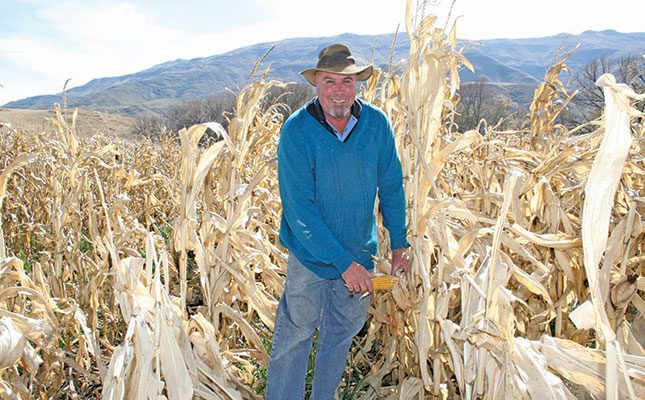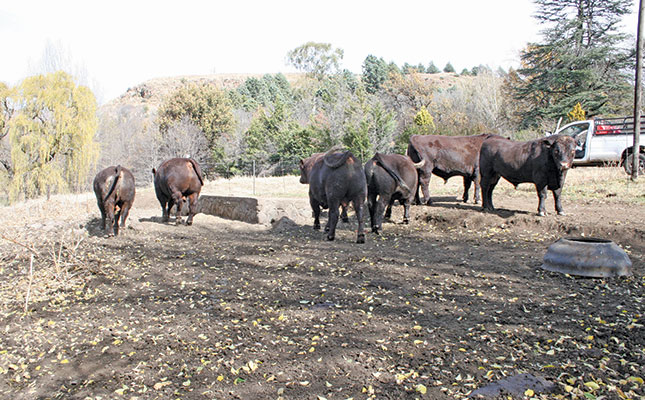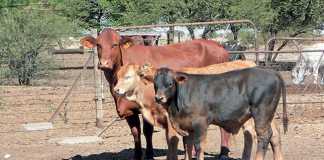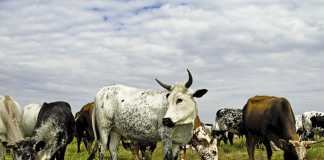
Photo: Gavin Isted
Geoff Orpen grew up on his father Mike’s farm Avoca near Barkly East. He embarked on full-time farming after the COVID-19 pandemic hit in 2020.
The farm has been in the Orpen family since 25 July 1866. Joseph Orpen, a famous surveyor from England, came to South Africa in 1854. As from 1862, he was responsible for surveying many farms in the Barkly East, New England and Lady Grey areas.
The Orpen family ran a well-known Arab horse stud on Avoca for many years. Mike’s grandfather (Geoff’s great-grandfather) Claude was responsible for bringing Arab horses to South Africa in 1911. He was also elected as the very first president of the National Wool Growers’ Association of South Africa.
Fifty percent of the Orpen farm was sold in 1933 to pay off a bank overdraft of £20 000 (about R28 million today). In 2013, Geoff bought back Millerd, the section sold off in 1933, and the farm is thus back to its original size.
Natural pastures
Avoca farm is 5 000ha in size, containing mixed mountainous grass veld of sweet and sour grasses, with the mountainous veld on the south-facing slopes being covered with unpalatable grass species such as wire grass (Elionurus muticus) and mountain wire grass (Merxmuellera disticha), and odd patches of turpentine grass (Cymbopogon spp).
The northern slopes contain more palatable grasses, such as red grass (Themeda triandra), Setaria species such as small creeping foxtail (S. flabellata), and Eragrostis species such as weeping love grass (E. curvula), and curly leaf grass (E. chloromelas). The average rainfall on Avoca is 875mm/year.
Problem plants are ouhout (Leucosidea sericea) on the mountain slopes and crack willow (Salix fragilis) along the mountain streams. Ouhout is set back by veldfires, but young shoots soon start from the roots after burning.
Crack willow is ring-barked and poisoned but it remains a never-ending struggle to control this fast grower, says Geoff.
The carrying capacity of the farm is 4ha/LSU to 5ha/LSU and 1ha/STU. The average camp size of the farm is about 200ha. Rotational grazing is used to keep the farm in top production. Geoff is also a firm believer in good soil conservation practices.
All the water is from fountains and mountain streams. Where strong fountains occur, the water is piped in plastic pipes to reservoirs and from there to troughs. Arable lands total 350ha, of which 30ha have been planted to lucerne and 40ha are used yearly for maize.
The remainder are planted annually with SSR 1 ryegrass for green feed. The soil of the lands is a basaltic black clay loam type.
The lands form an important part of the farming set-up, as Geoff believes it is important to be able to produce both lucerne and maize, especially for using as fodder for his stud animals to get them in condition before the yearly production sale.
Cold area
Geoff is one of the very first farmers who started to plant maize in this area. It can get very cold, with frost a possibility. The old varieties of maize took too long to form heads and suffered severe frost damage compared with the newly available fast-growing varieties.
Geoff prefers using DEKALB 6194, which is supposed to ripen within 105 days after planting. However, in the Barkly East area, this hybrid takes 120 days to ripen due to the cooler climate.
Geoff also plants Pannar BR3597 with good results. He plants his maize at 65 000 plants/ ha and fertilises with 3:2:1, containing 38% zinc and magnesium, at a rate of 150kg/ha. He then top-dresses with 100kg/ha of nitrogen (urea) or LAN when the maize is two months old.
This year, his maize yield is averaging between 8t/ha and 9t/ha, which is above his normal yearly average of 6t/ha to 7t/ha.
Geoff’s father, Mike, was farming on Avoca from 1930 to 1985. From 1962 to 1968, the farm had a large flock of Hampshire Down sheep running on it.
In November 1968, scrapie broke out, and the only way out was to destroy all the animals on the farm. Strangely, the Merino sheep were not affected by scrapie.
After this setback, Mike started to look for an animal that was hardy and fertile, could adapt well to the area, and use the natural veld for excellent production without being pampered.
After much research, he decided on the Sussex cattle breed. This was first run as a commercial herd until 1972, when he decided to intensify his breeding efforts.
Mike’s meticulous record-keeping and performance testing enabled him to register the herd as a stud. In 1973, the first stud bull, Hoathly Despot, was imported from the UK.
In 1976 at the Rand Easter Show in Johannesburg, four sons of this bull were sold for R17 000 (now about R897 000). That same year, the farm’s wool cheque came to a total of R9 000 (R475 000). Mike was then able to put up the existing shed on the farm of 70m x 40m for R3 000 (R158 000).
Geoff started part-time farming in 1990, and Mike retired in 1991 to Gonubie near East London. Geoff continued farming Sussex cattle and Merino sheep.
He used to sell Sussex bulls at the Kuruman Bull Sale and some off the farm until 2015, when he decided to host a local production sale.
Not having enough bulls on his own for a sale, he teamed up with Johan du Randt of the Mountain Shadows Sussex Stud and they decided to have an annual production sale in Aliwal North, as it would be more central and easier for buyers.
This sale is always held on the first Tuesday of September, and was held on 4 September this year.
Mating and selection
During 2008, Geoff started a Dormer sheep stud by buying in 150 ewes. The rams are also sold at the annual production sale. Geoff also runs a commercial flock of 2 800 Merino ewes and wethers, and 1 200 Dormers.
His Sussex herd consists of 100 stud cows and 280 commercial cows. The mating season for both stud and commercial herds occurs from 1 December to the end of February annually, for calving in September to the end of November.

Stud and commercial flocks are mated from 20 March to 15 April every year, and lamb from August to September.
The Sussex stud is treated exactly the same as the commercial herd. This, says Geoff, is to encourage hardiness. He uses performance testing and BLUP as a guide to selection, but also emphasises visual appraisal and touch as important in the selection process.
When selecting a bull, Geoff says he pays special attention to bloodline, birthweight, weaning indices, and fertility. Heifers are never mated before 24 months of age to allow them to grow out well because of the harsh winters in this area, says Geoff.
He also believes in corrective mating for the Sussex stud. This involves the selection of specific bulls to correct faults that may appear in female animals.
Mating
Geoff generally uses his stud’s bulls for mating, but may bring in bulls from other breeders from time to time. When buying bulls, he prefers not to buy bulls older than 22 to 24 months old, he says.
In-calf cows and heifers receive licks with extra maize and lucerne added for the last two months of gestation. During summer, all cattle receive phosphate licks. The young weaned bulls are fed high-protein licks during winter and energy licks during summer.
The young bulls are rounded off at the age of 15 months, which is about 90 days before the annual production sale, with maize and milled lucerne.
In terms of averages, the stud shows an inter-calving period of 370 days. The average birthweight of calves is 38kg. The 180-day weight for bulls is 250kg to 255kg, while mature cows weigh between 520kg and 550kg and mature bulls between 800kg and 850kg.
The Dormers are inseminated using artificial insemination by selected sires. Semen from Ramsen and certain breeders is purchased and used. Geoff also believes in corrective mating for his Dormers.
In terms of selection, he places specific focus on fertility. Dormer ewes are first mated at 12 to 14 months of age. Rams are rounded off at about 10 months, about 50 to 60 days before the annual sale.
Merinos are mated naturally at the rate of one ram to 30 ewes. Geoff uses rams from stud breeders Tink Strydom and Stephan Nel in Barkly East.
Ewes are first mated at the age of 18 months old. All stud and commercial Merinos and Dormers are run on extensive conditions and fed licks throughout winter.
Geoff’s breed policy for rams and bulls is that they must be able to walk well, have good body depth, a sound structural framework, and a very fertile background. Dormer rams are primarily selected for meat production and not for wool.
For this reason, the conformation of a stud ram is crucial, with hardiness and muscle development as well as the correct balance between length and depth of body as key traits.
In terms of averages, the Dormer stud has a lambing percentage of 180%, while the weaning percentage is 160%. The 100-day weight average for rams is 38kg to 40kg. The average 12-month weight for rams is 90kg to 120kg.
Sheep are sheared only at the end of October each year because of the cold climate in this area.
Animal health
Sheep are dosed three to four times a year, depending on the weather conditions and rainfall. Geoff uses the blanket method in which all sheep are dosed with the same remedy at that time of the year.
Cattle are seldom dosed, except for tapeworm in calves and liver fluke. In terms of inoculations, sheep receive Multi-Vax P once a year, which protects against pulpy kidney, malignant oedema, black quarter, tetanus and pasteurellosis, and the bluetongue vaccine.
The young rams are inoculated with REV 1 for brucellosis.
Cattle receive annual inoculations of Blanthrax for anthrax and black quarter, and Covexin for clostridial bacteria. All heifers are vaccinated against brucellosis.
Sheep are dipped after shearing, as Australian itch mite is a problem. This also helps to control scab mite, keds, lice and ticks.
In this area, the African blue tick (Boophilus decoloratus) and the smooth brown tick (Rhipicephalus glabroscutatum and R. neumanni) are problematic.
The cattle are also plunge-dipped for lice and ticks. This is normally done in the spring in August or September.
Labour
Geoff has a reliable workforce, with many of his labourers having been in his employ for more than a decade. He occasionally uses casual labour when needed. His advice to young breeders is to never embark on new ventures recklessly.
He explains that research is essential: “Use tried and perfected practices, and always remember that production is the key to any successful farming venture. Use technology to improve bad practices and advertise on social media. To make a sale is important, but to follow up on a regular basis is crucial to success. Honesty and integrity are vital,” he says.
Phone Geoff Orpen on 045 971 9082, or 082 490 9647.











